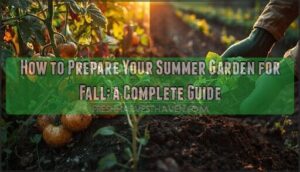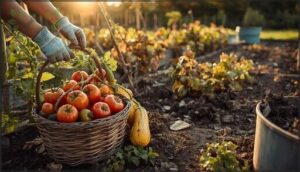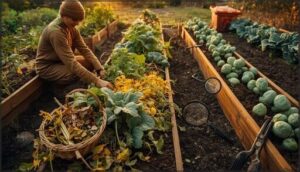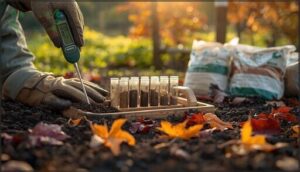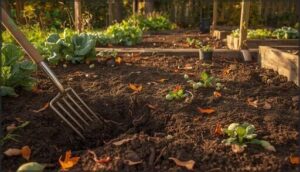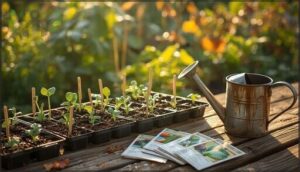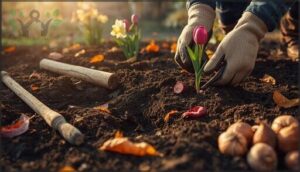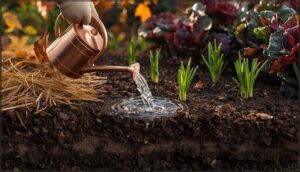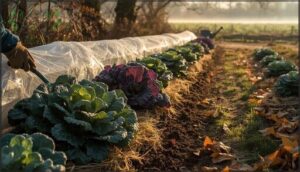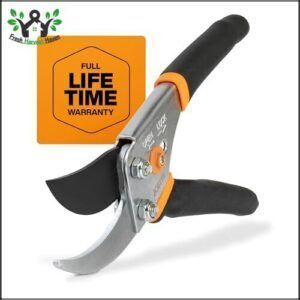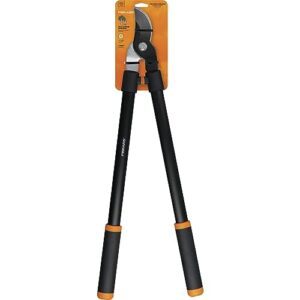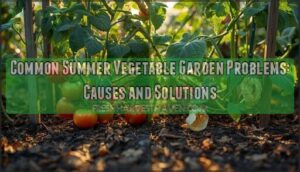This site is supported by our readers. We may earn a commission, at no cost to you, if you purchase through links.
Your tomato plants gave their all through August’s heat, but now they’re looking tired. The zucchini has stopped producing, and those bean plants are turning brown at the edges. September arrives with cooler nights, and your garden stands at a crossroads.
You can let summer plants fade away and call it a season, or you can transform that same soil into a productive fall garden. The secret lies in what you do right now. Preparing your summer garden for fall means more than pulling out dead plants. It starts with a clear-eyed assessment of what’s working and what’s not, followed by strategic soil prep and smart plant choices that thrive in cooler weather.
Table Of Contents
- Key Takeaways
- Assess Your Summer Garden’s Condition
- Harvest and Remove Spent Summer Crops
- Clean Up and Prevent Pest Problems
- Test and Amend Your Garden Soil
- Prepare Garden Beds for Fall Planting
- Plant Fall Vegetables, Bulbs, and Flowers
- Maintain and Protect Your Fall Garden
- Top 5 Essential Tools for Fall Garden Prep
- Frequently Asked Questions (FAQs)
- How do I prepare my garden for fall?
- Is it time to plant a fall garden?
- What are some fall garden tips?
- How do you make room for fall plants?
- What can you do in the fall garden?
- When is the best time to prepare soil for a garden?
- When should I stop watering my summer garden?
- How do I winterize garden irrigation systems?
- What temperature triggers first fall frost protection?
- Should I prune perennials before or after frost?
- Conclusion
Key Takeaways
- Assess your summer garden in early September by checking plant health, identifying pest issues, and recording what thrived or struggled in a garden journal to guide smarter decisions for next season.
- Clear out spent crops and test your soil’s pH and nutrient levels, then amend with compost and organic matter while the soil is still workable to create ideal conditions for fall planting.
- Plant cool-season vegetables, fall bulbs, and cold-hardy flowers 6-8 weeks before your first frost date, using proper spacing and mulching to protect new plantings through temperature swings.
- Maintain your fall garden by applying 2-3 inches of mulch to retain moisture and suppress weeds, covering tender plants when frost threatens, and monitoring soil health weekly to catch problems early.
Assess Your Summer Garden’s Condition
Before you plant anything new or make big changes, take a walk through your summer garden and see what’s really going on. This assessment helps you figure out what worked, what didn’t, and what needs your attention before cooler weather arrives.
Here’s how to evaluate your garden’s current condition and set yourself up for fall success.
Evaluate Plant Health and Performance
How do you know which plants are worth keeping? Visual assessment helps you spot water stress and disease signs before they spread. Walk through your beds and note growth metrics like leaf color and stem firmness. Up to 67% of garden plants show symptoms like wilting during peak season, so inspecting for diseases and pests now sets you up for better disease prevention. One common sign to look for is wilting leaves, which can indicate plant stress.
Look for these key indicators:
- Leaf appearance – yellowing, browning, or scorch marks signal trouble
- Growth patterns – stunted stems or sparse foliage need attention
- Yield analysis – plants producing less than expected may be struggling
Identify Pest and Disease Issues
Once you spot stress signs, check closely for the culprits. Inspecting for diseases and pests now prevents bigger headaches later. In 2024, spotted wing drosophila topped grower concerns at 21%, while honey fungus has led disease reports since 1995.
With the professional market growing, pest control is crucial for home and garden health. Early pest identification and recognizing disease symptoms mean you can apply organic controls before damage spreads—key steps for effective resistance management and reducing environmental impact.
| Common Pests | Common Diseases |
|---|---|
| Spotted wing drosophila | Honey fungus |
| Armyworms, cutworms | Apple and pear scab |
| Japanese beetles, aphids | Rose black spot |
| Stink bugs, thrips | Powdery mildew |
Note Thriving and Struggling Plants
After checking for pests and diseases, compare how your plants actually performed this season. Look at growth indicators like height, leaf color, and harvest rates—which can vary tenfold between plots.
Environmental factors such as sun exposure and watering directly affect plant performance, while your management strategies for pruning, weeding, and pest control shape outcomes.
Write down what thrived and what struggled to guide smarter decisions next year.
Plan and Record Changes Using a Garden Journal
Once you know which plants succeeded or failed, capture those insights in a garden journal. Record planting dates, bloom tracking notes, and pest incidence to inform your seasonal planning and crop rotation strategy.
Digital adoption of garden planner apps has jumped 38% recently, making garden maintenance easier. A well-kept journal transforms evaluating garden needs from guesswork into garden planning backed by your own data.
Harvest and Remove Spent Summer Crops
As summer winds down, your garden still has plenty to give before you shift gears for fall. Harvesting what’s left and clearing out spent plants creates a clean slate for the next season.
Here’s how to wrap up your summer garden and set the stage for fall success.
Harvest Remaining Vegetables and Fruits
Your harvest timing determines both crop yields and quality. Pick tomatoes when fully colored and slightly soft, though green ones ripen indoors if frost threatens.
Harvest beans and cucumbers every one to two days to boost production by up to 40%.
Root vegetables like carrots and beets can wait under mulch for extended harvesting into early winter, maximizing your vegetable garden’s output.
Remove Finished Annuals and Weeds
Clearing wilted annuals and weeds now prevents pests and diseases from settling in over winter. Early fall is your window for annual removal timing before cold weather locks problems into the soil.
5 Steps for Effective Removal:
- Pull entire root systems using sharp shears or a garden fork
- Target weeds aggressively to cut next year’s seeds by 60%
- Inspect plants for disease or pest damage before composting
- Trash any infected material instead of composting it
- Leave healthy roots intact to protect soil health and beneficial microbes
This thorough approach to removing spent annuals and weeding sets up clean beds for next-season planting.
Collect Seeds From Mature Plants
Before harvesting vegetables, check seed maturity by ensuring pods or heads are 80–90% dry on the plant. Collect seeds from beans, tomatoes, and peas for your fall garden.
Use proper drying methods by spreading seeds on screens below 95°F. Store in cool conditions under 50°F to maintain viability rates above 85%.
Seed saving preserves varieties and cuts costs season after season.
Compost Safe Plant Material
Your summer garden can keep giving back if you compost wisely. Add grass clippings, healthy leaves, and kitchen scraps like vegetable trimmings to your pile. These materials balance decomposition and build organic matter. Never include black walnut parts or diseased plant debris in your compost.
Yard waste makes up 41% of household composting efforts, and properly managed piles achieve ideal nutrient ratios around 10:1 carbon to nitrogen.
Clean Up and Prevent Pest Problems
A clean garden is your best defense against pests and diseases that try to hitchhike into fall and spring. Lingering debris and rotting plant material create perfect hiding spots for insects and pathogens that will cause problems down the road.
Here’s how to clear away trouble and set your garden up for a healthier season ahead.
Dispose of Diseased Debris and Fallen Fruit
Disease survival starts in the debris you leave behind. Infected fruit and autumn leaves harbor fungal spores that can slash next year’s crop health by 80%.
You’ll want to dispose of diseased material through municipal green waste programs—they reach temperatures above 60°C, destroying 99% of pathogens. Bury debris 30 cm deep or use sealed black plastic bags in sunlight.
Safe disposal now means healthier plants come spring.
Remove Decaying Flowers and Foliage
Deadheading spent blooms weekly redirects energy toward stronger roots and can boost next season’s flowering by up to 30%. Snip faded flowers just above a leaf node using clean pruners. This simple garden maintenance tip prevents fungal diseases from overwintering in decaying tissue.
Balance disease prevention with habitat needs by leaving 10-20% of dried stems for beneficial insects sheltering through winter.
Mulch Beds to Disrupt Overwintering Pests
After clearing out dying foliage, spread a two to three inch layer of mulch across your fall garden beds. Cedar or wheat straw works best for disrupting overwintering pests while supporting beneficial insects. Studies show this simple mulching practice can reduce pest populations by 40-70% next spring.
- Apply mulch in late fall after pest activity slows
- Choose cedar, cypress, or pine bark for natural pest deterrence
- Maintain proper depth to avoid excessive pest sheltering
- Rake mulch lightly in early spring to expose lingering larvae
Use Organic Pest Controls
Beyond mulching, you can leverage the expanding market of biopesticides for your vegetable garden. These organic solutions offer impressive effectiveness—some reduce weeds by 99% while cutting pesticide residues to one-third of conventional methods.
Their ecological impact includes healthier soil biology and stronger beneficial insect populations. While initial costs run higher, economic considerations improve over time through reduced pest pressure and premium organic gardening value.
Test and Amend Your Garden Soil
Your soil holds the key to a thriving fall garden. After a busy summer of growth, it’s likely depleted of essential nutrients and may have shifted in pH balance.
Testing and amending your soil now sets the stage for healthier plants and better harvests in the months ahead.
Test Soil PH and Nutrient Levels
Why guess when you can know for sure? A simple soil test reveals your soil pH and nutrient levels before fall planting begins.
Send a soil sample to your local extension office or use a home testing kit to measure soil acidity and detect nutrient deficiency.
Most vegetables thrive when soil pH stays between 6.0 and 7.0, where plant health improves through better nutrient availability.
Add Organic Matter and Compost
Once you understand your soil’s needs, adding organic matter brings lasting benefits of composting to your fall garden.
Work compost or aged plant material into the top four to six inches to improve soil structure and boost biological activity. This simple step enhances nutrient cycling while diverting waste from landfills.
Apply about one to two inches across your beds for healthier roots and stronger plants.
Incorporate Manure and Soil Conditioners
After adding compost, spreading manure and soil amendments takes your fall soil preparation to the next level. Apply 75 pounds of dairy cow manure or 40 pounds of sheep manure per 100 square feet for solid nutrient delivery.
These organic practices improve soil structure while boosting enzyme activity by up to 50%. Work amendments into the top layer when soil drops below 50°F to optimize benefits.
Adjust Soil Acidity With Lime if Needed
When your soil test reveals a pH below 6.0, liming corrects acidity and unlocks nutrient availability for healthier plants.
Apply 35 pounds of dolomitic lime per 1,000 square feet to raise pH from 5.0 to 6.0. Work lime into the top six inches of soil this fall.
Full pH changes take several months, so test annually and adjust application rates based on your soil’s texture and crop needs.
Prepare Garden Beds for Fall Planting
Your garden beds need proper preparation to give fall plants the best chance at thriving. The work you do now sets the stage for healthy root development and strong growth throughout the cooler months.
Here are four key steps to get your beds ready for fall planting.
Till or Loosen Soil for Improved Structure
Loosening compacted garden soil in fall creates pockets that let oxygen, water, and nutrients reach roots more effectively. This step transforms tired beds into thriving growing spaces. Here’s why fall tilling improves your soil structure:
- Aeration benefits boost root health by creating oxygen-rich channels for better nutrient access
- Tilling methods break up hard clay, improving drainage and root penetration
- Amendment incorporation mixes compost evenly throughout your beds
- Pest disruption exposes overwintering insects, reducing spring problems naturally
Consider the microbial impact—while tilling improves immediate soil structure, avoid overdoing it to protect beneficial organisms.
Rotate Crops to Prevent Disease Buildup
Planting the same crop families in the same spots year after year invites trouble. Crop rotation breaks pest cycles and prevents disease buildup that can reduce yields by up to 80%. Wait at least three to four years before returning crops from the same botanical family to a bed.
Crop rotation every three to four years breaks pest cycles and prevents disease buildup that can slash yields by 80%
This simple planning boosts soil health naturally and reduces pest outbreaks by an impressive 25%.
Use Fallen Leaves as Mulch or Compost
Those autumn leaves falling across your lawn are garden gold. Shredding leaves with a mulch mower before spreading them creates a nutrient-rich layer that adds over three pounds of nitrogen per 1,000 square feet.
Leaf mulch benefits include better moisture retention and natural weed suppression. You can also add this organic matter to your compost pile, boosting soil enrichment while achieving significant waste reduction.
Decide if Fresh Manure is Safe to Use
Fresh manure poses serious pathogen risks, including E. coli and Salmonella, in your garden soil. Regulatory manure standards require waiting 120 days before harvesting crops with soil contact.
The safest approach when preparing soil in fall uses properly composted organic matter instead. Composting best practices demand temperatures reaching 140°F to eliminate harmful bacteria.
For soil preparation and amendment this season, choose commercially processed manure to avoid soil contamination hazards and protect your family’s health.
Plant Fall Vegetables, Bulbs, and Flowers
With your beds prepped and ready, it’s time to fill them with plants that thrive in cooler weather.
Fall offers a second growing season for vegetables, flowers, and bulbs that need cold to perform their best.
Here’s how to choose and plant the right varieties for a productive and beautiful fall garden.
Choose Fall-blooming Annuals and Perennials
Beyond replacing spent summer blooms, fall gardening extends your growing season with colorful annuals and hardy perennials that thrive when temperatures drop. Planting time starts 6-8 weeks before your first expected frost to allow proper root establishment.
- Fall annuals like pansies and salvias offer continuous bloom duration until frost and some deer resistance
- Perennials such as asters and mums provide essential pollinator support and return yearly
- Container choices work beautifully for urban gardens with limited space
Start Cool-season Vegetables From Seed
Cool-season vegetables offer your fall garden fresh harvests when you start seeds at the right time. Begin broccoli and cabbage indoors about 3 months before frost, while direct sowing works better for carrots and beets since their roots hate disturbance.
Seed quality matters—higher germination temperatures around 40°F help cold weather crops establish quickly. Indoor methods give slow growers a head start, but timing strategies determine your success with seed starting.
Plant Bulbs for Spring Blooms
While preparing your fall garden for cool-season crops, don’t skip spring planting opportunities. Plant bulbs now, 6–8 weeks before frost, when nighttime soil temperatures drop to 40–50°F.
A planting depth guide suggests setting large bulbs like tulips 6–8 inches deep and smaller varieties 3–4 inches deep. Bulb size matters—larger ones produce showier blooms.
Bulb chilling needs vary by zone, so check requirements. Proper spacing prevents crowding, while post-planting care ensures healthy root development.
Water and Mulch New Plantings
Once your bulbs and cool-season crops are settled, watering frequency and mulch types become your next focus. Water new plantings deeply every 3–4 days for the first few weeks to promote root establishment. Check soil moisture at 4–6 inches—if it’s dry, water again. Then apply 2–4 inches of organic mulch to lock in hydration and regulate temperature.
Fall garden preparation essentials for nourishing soil and garden care:
- Deep watering beats shallow spritzing—roots need to reach down 16–18 inches for stability through winter’s chill.
- Mulch cuts your watering work in half—organic layers trap moisture and feed the soil as they break down.
- Adjust as temperatures drop—gradually shift from twice-weekly sessions to biweekly checks, following nature’s rhythm.
- Watch for sneaky dry spells—even in fall, two weeks without rain means your plants need a drink.
Maintain and Protect Your Fall Garden
Once your fall garden is planted, the work isn’t over. Consistent care helps your plants stay healthy through temperature swings and changing weather patterns.
Here are the key maintenance tasks that will keep your fall garden thriving until winter arrives.
Mulch to Conserve Moisture and Suppress Weeds
Mulch acts like a cozy blanket over your beds, boosting water retention by up to 22% during dry autumn stretches. A 2–3 inch layer of organic mulch—autumn leaves, bark, or wood chips—blocks sunlight from reaching weed seeds, drastically cutting down on weed suppression needs.
Proper mulch application rates stabilize soil temperature and improve soil health by feeding beneficial microbes as it breaks down.
Shield Tender Plants From Early Frost
When frost threatens, timing makes all the difference for tender plants. Cover them before nightfall using lightweight row covers that provide 2–6°F of frost protection, or clear plastic for up to 10°F. Anchor edges to trap warmth and remove coverings once temperatures reach 50°F.
Watering beforehand raises root zone temperatures by 5°F, giving your garden extra defense against that fall frost date.
Tend Compost Piles for Winter Breakdown
As temperatures drop, your compost pile needs attention to keep microbial activity going strong. Aim for a 3x3x3-foot pile size that holds heat better during cold snaps.
Balance moisture—damp but not soggy—and maintain a 25:1 to 35:1 C:N ratio by layering fall leaves with kitchen scraps.
Adding organic matter this way ensures steady winter breakdown and rich compost by spring.
Regularly Monitor Plant and Soil Health
Check your soil pH and nutrient levels every four weeks to catch deficiencies before they stunt root development or harm microbial life. Regular yield data analysis reveals patterns that guide smarter soil amendments and boost nutrient availability season after season.
Weekly walks help with pest early detection—spotting aphids or disease saves you from bigger headaches later. Automated monitoring tools track environmental stress factors like moisture and temperature fluctuations.
Top 5 Essential Tools for Fall Garden Prep
Having the right tools makes fall garden prep faster and less frustrating. You don’t need a shed full of equipment, but a few solid basics will help you tackle soil prep, pruning, and cleanup with confidence.
Here are five dependable tools that handle the heavy lifting when converting your summer garden into fall.
1. ZUZUAN Heavy Duty Garden Tool Set
You can’t prepare your garden for fall without the right hand tools. The ZUZUAN Heavy Duty Garden Tool Set gives you three essential pieces: a hand trowel, transplant trowel, and cultivator rake.
Their aluminum durability stands up to fall garden preparation tasks like cleaning and clearing garden beds. The ergonomic design reduces hand fatigue during soil prep and adding mulch or leaves.
Customer feedback highlights their rust resistance and comfortable grip. Simple tool maintenance—cleaning and drying after use—keeps them ready for years of gardening applications.
2. Fiskars Bypass Pruning Shears Clippers
Pruning shears are your go-to tool for trimming and pruning plants as summer fades. The Fiskars Bypass Pruning Shears feature hardened steel blade material with a low-friction coating that stays sharp through heavy use.
Their ergonomic design reduces hand strain during harvesting and pruning sessions. With a cutting capacity up to one inch, you’ll handle most fall cleanup tasks with ease.
Customer satisfaction ratings average 4.7 out of 5 stars, with 91% of users recommending them. The durability and lifetime warranty mean these pruning shears become a long-term garden companion.
3. Crack Weeder Tool for Weed Removal
Weeds don’t stop growing just because summer ends. A specialized crack weeder lets you clear joints between pavers and sidewalks where stubborn weeds take hold.
This 13-inch tool features a sharpened stainless steel blade and beech ergonomic grips for comfortable joint weeding. Its L-shaped design addresses multiple angles while the sharp edge lifts out tap-rooted weeds intact.
With tool durability backed by hardened steel construction, you’ll find varied applications from edging grass lines to cleaning patio cracks. It’s an affordable addition to your garden maintenance toolkit for fall garden preparation.
4. Fiskars 28 Inch Steel Loppers
After clearing weeds, you’ll need proper pruning power for fall garden preparation tips. The Fiskars 28 Inch Steel Loppers handle branches up to 1.5 inches with compound lever technology that doubles your cutting capacity compared to standard tools.
The hardened steel blade maintains sharpness through heavy use, while shock-absorbing bumpers reduce hand strain during extended sessions.
With a 4.8-star rating and lifetime warranty details backing this sub-$30 tool, you get reliable blade durability and user comfort for seasonal garden maintenance tips without breaking your budget.
5. Cooljob Women’s Gardening Gloves Six Pairs
Your hands take a beating during fall garden preparation, so the Cooljob Women’s Gardening Gloves Six Pairs deliver reliable protection without sacrificing comfort. Each pair features thickened fingertips and latex coating for glove durability during weeding and planting tasks.
The breathable knit base prevents sweating, while extended cuffs keep debris out when moving between garden beds. With positive sizing accuracy reviews and six color-coded pairs for under $9, you get an excellent value proposition for fall gardening techniques.
Machine washable construction means they’ll last through multiple seasons of preparing your garden for fall.
Frequently Asked Questions (FAQs)
How do I prepare my garden for fall?
Think of your garden as a stage between acts. Fall garden prep means clearing spent crops, testing and amending soil, rotating beds, and planting cool-season varieties—your seasonal planting guide to autumn success.
Is it time to plant a fall garden?
August and September mark prime fall garden planning windows in most temperate regions.
Count backward from your local frost date to time cool-season crops and succession planting correctly, with soil temperature allowing for seed germination.
What are some fall garden tips?
Strike while the iron is hot with fall garden prep. Test your soil, amend with compost, rotate crops to prevent disease, mulch beds to disrupt pests, and plant cool-season vegetables for continued harvests.
How do you make room for fall plants?
You make room through succession planting and interplanting seedlings among maturing crops. Removing spent plants opens beds for cool-season crops. Layered plantings and strategic crop removal optimize space while preserving soil structure throughout converting garden beds.
What can you do in the fall garden?
Your fall garden becomes a sanctuary for seasonal planting, from sowing cool-season crops and enriching soil health to protecting against pests—autumn gardening truly extends your harvest and nurtures sustainable practices.
When is the best time to prepare soil for a garden?
You should test your soil every one to two years and prepare it in early spring or fall.
Work amendments into the top six inches when the soil crumbles easily in your hand.
When should I stop watering my summer garden?
You should stop watering your summer garden when soil moisture stays consistently damp from regional rainfall and frost arrives.
Most summer vegetables enter plant dormancy before equipment shutdown protects your irrigation system from freeze damage.
How do I winterize garden irrigation systems?
Before the frost arrives, drain all water from your irrigation lines using compressed air. Inspect nozzles and insulate backflow devices to prevent costly freeze damage during the winter months.
What temperature triggers first fall frost protection?
When nighttime temperatures hover between 36°F and 32°F, frost advisories trigger the need for protecting tender plants in your autumn garden.
Below 28°F signals a hard freeze warning, demanding immediate action before plant damage occurs.
Should I prune perennials before or after frost?
Wait until after several hard frosts to prune most perennials. This timing ensures plant dormancy and prevents new growth vulnerable to cold damage.
Post-frost pruning also removes decaying foliage that harbors pests and disease.
Conclusion
September’s shift signals more than summer’s end. It brings a second season of growth if you act now.
Preparing your summer garden for fall transforms tired soil into productive ground through strategic cleanup, thoughtful amendments, and smart crop choices.
Your garden journal holds next year’s lessons. Your compost pile fuels future harvests. The tools in your shed stand ready.
Cool-season crops thrive in autumn’s embrace when you give them properly prepared beds to call home.
- https://www.extension.purdue.edu/extmedia/HO/HO-66-W.pdf
- https://www.themillstores.com/blogs/lawn-garden-blog/how-to-prepare-your-garden-for-fall-a-step-by-step-guide
- https://www.tpslab.com/the-importance-of-fall-soil-testing-for-farms-and-gardens-maximize-your-soils-potential-before-winter
- https://ipm.cahnr.uconn.edu/leaf_disposal_mulch_mowing/
- https://www.jwalshgardens.co.uk/uncategorized/top-7-fall-gardening-trends-for-2025-sustainable-stylish-and-smart/

